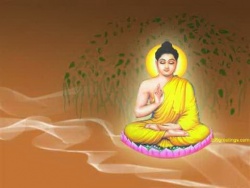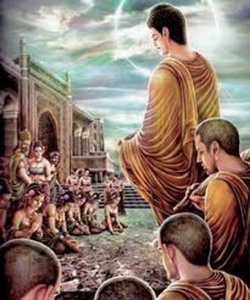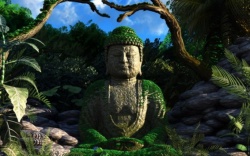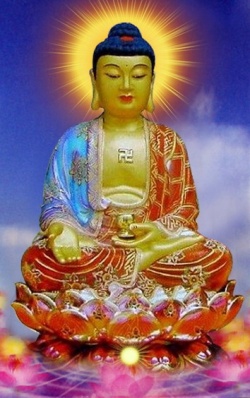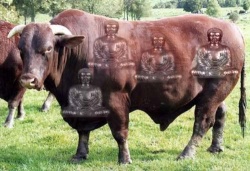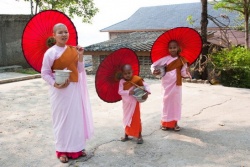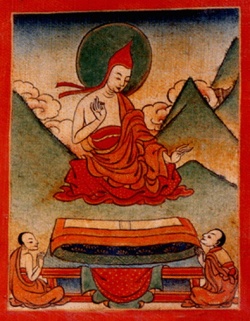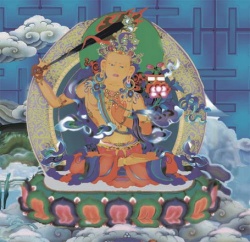Ethnic Buddhism and Other Obstacles to the Dhamma in the West by Dr Victor Gunasekara
1. Some Preliminary Issues
Introduction
Buddhism which for over two millennia had been confined largely to the Asian continent has during the past century spread to Europe, America, Ocenia and Africa. In Asia itself different forms of Buddhism emerged of which three forms the Theravada (largely confined to South and South-East Asia), the Mahayana (China, Korea and Japan) and the Vajrayana (Tibet and Central Asia) are the best known. There are doctrinal differences in these forms of Buddhism but they also have cultural differences derived from the countries in which they are practices. Even within a given tradition there are differences, e.g. Theravada in Sri Lanka, Burma and Thailand have some cultural differences.
The Western encounter with Buddhism began first with some scholarly interest in the subject and later a few Westerners formally embraced Buddhism some even becoming monks (Bhikkhus). Many of the latter got ordained in Asian countries and consider themselves as belonging the Order in which they had ordained. Many Buddhists from Asian countries have migrated to the West and they form the bulk of practicing Buddhists in the West today. Both Asian Buddhist migrants and Western Bhikkhus ordained in Asian countries tend to have some ambivalence between Buddhism as a universal religion and the ethnic variant of the country in which they had been fashioned. This has created some problems and it is with these that this essay is concerened.
While what is said here will apply to Buddhism in the West generally the primary focus has been Theravada Buddhism of the Sri Lankan tradition as currently practiced in Australia. It was only in the last quarter of the twentieth century that Sri Lankan Buddhists migrated to Australia in large numbers and they have established Buddhist viharas in all the major cities of Australia. While our focus is with the practices of these Sri Lankan Budhists in Australia many of their problems are also faced by Asian Buddhists migrating to other Western countries.
Some attention is also paid to meditation-centered Buddhism. This is of course not an exclusively ethnic phenomenon. Meditation has been part of the Buddhist way but the tendency we will be considering is that which considers stylised meditation as almost the whole of Buddhism. This is considered as one of the obstacles to a true understanding of Buddhism in the West.
What is Buddhism?
This essay is concerned with some obstacles to the spread of the Dhamma in Western countries. This requires a consideration of some basic questions on the nature of Buddhism, and the institutional forms it has taken in the West. Buddhism is the name given to the teaching of Siddhatta Gotama, who is better known as the Buddha, and Buddhists are those who affirm the validity of his teaching. Buddhists themselves refer to the teaching by the Pali [1]term Dhamma (or in some schools of Buddhism by its Sanskrit equivalent dharma). One of the root meanings of this word is "to uphold" (dh.r in sanskrit), and in this sense is used to denote that which underlies and upholds the Universe. It has sometimes been translated as the Norm or the Law.
Whether the Dhamma constitutes a religion or not has been debated variously. It is certainly not a religion in the Judeo-Christian-Islamic sense because it is not based on the blind acceptance of the word of someone who claims to be a teacher, "prophet" or kinsman of a supreme God. On the other hand it cannot simply be equated with Science, Philosophy or Psychology as these secular disciplines are commonly understood. Two characteristics of the Dhamma separate it from these latter disciplines.
The Dhamma postulates a strict normative set of values including a moral code while secular, "non-religious", sciences tend to be positivistic and adopt a neutral stance on moral and ethical questions.
The Dhamma postulates survival after death in some form or other. On this question there are some differences of opinion. But the popular interpretations of the Dhamma do make it clear that some kind of future life could be expected for persons who have not fully liberated themselves. The status of the fully liberated one after death has been more problematical. However a completely rational interpretation of the dhamma can be validated from the Buddha's teaching, although this aspect is not developed in this essay. [2]
Because of these characteristics Buddhism falls into a broader definition of religion than the one traditionally used in the West. Indeed such a change of definition is coming into general use. As such Buddhism can be considered a religion and compared with the other religions in the world. Buddhists should compare the claims of Buddhism against these other religious systems. A taxonomy of religious systems is necessary to do this effectively.
Universal and Particular Religions
Religions could be classified into those that are "universal" and those that are "particularistic" in scope. The requirements of a universal religion are stated later, but the distinction depends crucially on the eligibility of persons for membership either as ordinary followers or as some kind of elite within the religion concerned. Examples of major religions that are generally considered "universal" are (in order of their appearance) Buddhism, Christianity and Islam. On the other hand we may regard Judaism and Hinduism as examples of particularistic religions because their membership is limited to certain people on the basis of some criteria whether national or ethnic.
As with most generalisations there are exceptions to this simple division of religions. Religions that have generally been considered particularistic and exclusive have attempted in recent times to broaden their appeal and relax some of the strict criteria relating to those who are allowed within their fold. On the other hand basically universalistic religions have developed national and ethnic variations which have considerably narrowed the scope of the religion when such ethnic variation is used in a given manifestation of the religion.
Thus some people who are not ethnic Jews (e.g. Ethiopians and even a few American Blacks) have been admitted into Judaism, and recently people of ethnic European descent have embraced the Hare Krishna version of Hinduism. In both cases they have not been universally accepted by their co-religionists. Many ethnic Jews oppose the validity of the conversion of non-Jews into Judaism, and the claim of Western Hare Krishna priests have been challenged by orthodox Hindus as they are not of the Brahmin caste by birth. The existence of such exceptions do not deny the basically ethnic character of these religions.
Another characteristic of particularistic religions is that they are confined largely or exclusively to people of a given nationality or ethnicity even though the beliefs of these religions may not require it. It is in this sense that Shinto and Sikhism can be considered to be ethnic religions. This is also true of the religious views of many so-called primitive peoples, tribes, etc. because these beliefs are part of the culture of the people concerned. We shall use the terms "particularistic religion", "ethnic religion" and "cultural religion" almost synonymously, and in every case in contradistinction to those religions that are considered universal religions.
When we are speaking of "ethnic Buddhism" we are referring to a manifestation of Buddhism which runs counter to its historic universalistic character. Cultural aspects may not be obvious in the national manifestations of Buddhism, but become quite distinct, and create problems, when they are transplanted into other cultures.
Characteristics of a Universal Religion
The characteristics which make a religion universal in scope are the following:
Universality of Principle. There must be nothing in the basic beliefs of the religion that confine it to a particular nation, race or ethnic group. Thus if there is a notion of a "chosen people" then this characteristic is violated.
Non-Exclusiveness of Membership. Any person could be an adherent of the religion concerned, and be entitled to the same privileges and obligations as every other person. This of course does not require every follower of the religion to be of the same level of achievement, but only that some external factor like race or caste prevents individuals from full participation in the religion.
Wide Geographical dispersion. The religion must have demonstrated an ability to find followers amongst a variety of nations or ethnic groups. Thus even if a religion satisfies the first two requirements but have not been able to spread beyond its region of origin it may not qualify to be a universal religion. Thus Jainism is not generally regarded as a universal although its principles are universal in scope and it is non-exclusive.
Non-Exclusiveness of Language. The practices of the religion which require verbal communication should be capable of being done in any language. The authoritative version of its basic texts may be maintained in the original language in which the original expositions were given, but translations of these should be valid, provided that they preserve the sense of the original texts. [3]
Independence of Specific Cultural Practices. The practices of the religion should be free from the cultural practices of a particular group in such matters as food, dress, seating, etc. Each one of these criteria raise problems but they have to be satisfied to a significant extent if the religion is to be deemed a universal one.
On the basis of these characteristics Buddhism, as originally expounded by the Buddha, can be described as a universal religious system par excellence.
Practical Considerations
During the many centuries of its existence Buddhism has been practiced in different cultures and has acquired some of the ethnic peculiarities of the culture concerned. This is also true of some of the other religions as well that are generally considered universal in scope. Thus we can speak of the Ukrainian Orthodox Church or the Dutch Reformed Church which seems to present certain cultural variants of Christianity in Ukraine or Holland. The Shi'a school of Islam may also be considered an ethnic variant of Islam as it is confined largely to people of Iranian descent.
Ethnic variants of universal religions are thus common, but so long as the cultural and ethnic content of these religions relate to secondary matters, and the ethnic variant is used only in the particular country where the cultural tendencies emerged there may not be any serious damage done. We have then the case of a religion adapting itself to a particular national or cultural milieu without sacrificing any of its fundamental universalistic precepts. Particularly when a religion is practiced in a country for several centuries, and there has been little contact with other nationalities that may practice the same religion, such ethnic and national variants can emerge. This explains why ethnic variants have emerged in all the three main universal religions we have mentioned.
Problems with the ethnic variants of universal religions can arise when the followers of these religions migrate to a different country and carry with them not only the universalistic aspects of their religions but also the cultural elements. The correct attitude should be to give precedence to the universal aspects and discard those cultural aspects that have little relevance to the new culture of the migrant. Often however it is the cultural aspects that are given an overriding importance with the result that the religion is given a false image in the country into which the migrants have taken their religion.
The rapid development of means of transportation, the emergence of a global economy, and the standardisation of many aspects of life, has created an unprecedented movement of peoples in the world in recent decades. This mass migration has brought peoples professing various religions to live in areas where those religions have not been known widely. Countries like Australia which have traditionally relied on heavy migration from other countries provide very good examples but it is also seen in older settled areas like Europe and even Asia.
Australia has adopted the Multiculturalism as an official policy. It is however sad to see that Buddhism is sometimes also considered as part of this multi-culturalism. Strictly speaking the Dhamma is above cultural peculiarities and cannot be considered part of the baggage of "Multiculturalism". [4]
2. The Universality of the Dhamma
The Qualities of the Dhamma
It is not difficult to show the universality of Buddhism in terms of the characteristics we have identified. Traditionally Buddhists are those who "go for refuge" to the three "Gems" of Buddhism, viz. the Buddha, the Dhamma and the Sangha. Of these three it is only the second, refuge in the Dhamma, that is most relevant for the contemporary practice of Buddhism. Since the death of the Buddha one can really go for refuge to the Buddha by going for refuge to his teaching, i.e. the second traditional refuge.
We shall be concerned with the Dhamma as it is expounded in the Pali Canon which is generally considered to be the earliest of the Canons of Buddhism. The Buddha has always been regarded as a teacher for all humanity. Indeed the compass of his teaching may even exceed the human plane as one of the titles conferred to the Buddha is "teacher of humans and devas" (sattaa devamanussaana.m), and there are discourses that are said to have been given to non-human beings. Whatever the truth of this claim may be the bulk of the discourses of the Buddha given in the Pali Canon were delivered to humans, most of it to monks and some of it to laypersons.
In the Pali Canon there is an enumeration of the qualities of the Dhamma which establish clearly its universalist nature. The six qualities of the Dhamma that are mentioned in the traditional formulary are the following:
Clear Exposition (svaakkhaato). The clarity of the exposition means that it contains not esoteric element that might make it appropriate for a certain category of persons.
Self-realisation (sandi.t.thiko). This reduces reliance on an established priesthood or authorised "teachers". Individuals who are prepared to devote the necessary time can acquire the Dhamma by personal study, practice and experience.
Timelessness (akaaliko). This has two meanings: (a) the results of the dhamma could be seen almost immediately and (b) the dhamma is not circumscribed in time, and would not become irrelevant by the mere passage of time. It is the second of these interpretations that give it universal significance.
Empiricism (ehipassiko). The validity of the Dhamma could be seen by experimentation and observation through practice. It is not merely a theoretical assertion about life, but a verifiable statement.
Practicality (opanayiko). The Dhamma could be practiced ("entered upon") by any interested person.
Apprehension by the wise (paccatta.m veditabbo viññuuhiti). Measure of wisdom is necessary for its clear apprehension.
The first five of these qualities contribute to the universality of the Dhamma. The sixth is not taken to mean that only "wise" people are capable of apprehending it, but that wise people will apprehend it more readily than others. The fact that the Dhamma has these qualities does not automatically make it universal. Other religious systems may also lay claim to some of these qualities, but not to the totality of these. What is true of the "particularistic" religions is that they are restricted in some sense to a particular grouping, usually on the basis on ethnicity. We must therefore investigate the principal aspects of ethnicity that may affect the practice of a religion and see whether they manifest themselves in the Dhamma.
Buddhism as a missionary religion
Another testimony to the universalist character of Buddhism was that Buddhism was the world's first missionary religion. There was no evidence that any religion before it was interested in spreading it on a world-wide basis. Indeed the opposite was the case. Pre-Buddhist religions were more interested in excluding others from its fold rather than welcoming them. This is true of most tribal religions of primitive peoples who confined their religion to their own group. It was also true of other early religions, like the ancient Egyptian, Babylonian religions as well as the Brahmanical religion of India. The latter jealously guarded who were to be admitted, especially to the brahmin caste. The emerging religion of Judaism in the present middle-east was also keen in keeping it confined to the "chosen people". There were several other religions all equally exclusive.
In contrast to this dominant view the Buddha sought to proclaim the dhamma universally once he had resolved the problem whether to proclaim it at all. There are several instances where this is clearly proclaimed, perhaps for the first time in religious history. The classic utterance on this subject is recorded both in the Vinaya and the Sa.myutta Nikaaya. Quite early in his dispensation, when the number of Bhikkhus was still a handful, he addressed them thus:
Go ye, O monks, wander around for the good of the many, for the happiness of the many, out of compassion for the world, for the benefit, good and happiness of humans and devas. Let not any two go in the same way. Proclaim, monks, the Dhamma which is beautiful in the beginning, good in the middle and good at the end. Be exemplars of the pure life perfected and purified in every respect. There are beings with little dust in their eyes who will surely perish without the Dhamma, but who can join those other Dhamma-farers. I myself, monks, will go to Uruvelaa to preach the Dhamma.(SN i, 104-5).
This quotation more than any other captures the universalist spirit of the Dhamma. The Buddha not only exhorts his disciples to spread the Dhamma but himself set an example, an example that was to last his whole his life. It is also in this spirit that the Dhammapada proclaims that the "Gift of the Dhamma is the best of all gifts" (v.354).
The Indian ruler who gave expression to the Buddha's wish for the universal propagation of the Dhamma was the Indian emperor Asoka. His missions to many parts of the world was perhaps the first systematic attempt to spread a religion to the limits of the known world. Asoka was only partly successful, and many of his missions did not have a lasting effort. In the West it is only in Greece that Asoka's efforts had some success even though it was extremely short-lived. But Buddhism was successful in penetrating the most parts of Asia, even though in the process it underwent some change. The decline of Buddhism has seen many of these "gains" lost, and now it is declining even further particularly through the spread of the three Western religions of Christianity, Islam and Communism.
Christianity and Islam are the other two missionary religions in the world. However there is a great difference in the missionary methods adopted by Buddhism on the one hand and the theistic religions on the other. Buddhism sought to "convert" by using argument and example, but the theistic religions not only used force and violence but resorted to every manner of propaganda, bribery, trickery and deceit. Far from abandoning these methods the theistic religions are refining these techniques that have brought them so much success in the past.
Modern Buddhists have been lethargic in carrying out the injunction of the Buddha with regard to the propagation of the Truth. The efforts of true Buddhist pioneers like the Anagarika Dharmapala has been forgotten. Indeed the retreat into ethnic Buddhism is precisely a statement that those who resort to it are no longer interested in Dhamma propagation. While there are now a large number of Sri Lankan monks in Western countries they are not engaged in dhamma-duuta work, but in catering for the Sri Lankan communities abroad. In effect they are denying the universalist character of Buddhism are returning it to the particularistic mould of ethnic religion in contravention of the clear injunctions of the Buddha.
The Dhamma and Language
Perhaps the most important "ethnic" aspect that could influence the practice of a religion is language. The practice of a religion involves communication with other persons and the most powerful instrument of that communication is language.
Language impinges on religion in many ways. Firstly the doctrine of the religion has to be written down if it is to survive for posterity. Theravada Buddhism uses the Pali language. There is a great deal of dispute on the origins of Pali. It belongs to the Indo-European family of languages but whether it was the language of the Buddha is uncertain. As a Sakyan the mother tongue would certainly not have been Pali. Most of the Buddha's activity took place in Magadha where the dominant language Magadhan would have been used by the Buddha. Some scholars claim that Pali was the language spoken in the Ujjain region which the Buddha is not recorded as having visited. Others claim that it is an artificial language designed specifically to record the Dhamma and was never the spoken language of a group of people. Whatever the truth of the matter be it is clear that the Buddha's original discourses (in whatever language they may have been given) have been rendered into Pali by the arhats of old, and today forms the definitive corps of the Buddha's teaching according to the Theravada.
From the Pali the Dhamma has been translated into other languages. Unfortunately many of these translators took some liberties in their translation. This is also true of the English translations pioneered by the Pali Text Society. For this reason it is absolutely necessary to go to the original Pali texts if the true meaning of the Dhamma is to be discovered.
Whatever the language of the scriptures be there is the question of the popular dissemination of the Dhamma which cannot be done in a classical language which people do not understand. On this question there is a definitive pronouncement on the part of the Buddha. This occurs in the Vinaya Pi.taka when the two bhikkhu brothers Yameluketulaa question the Buddha on the appropriateness of using local languages for the exposition of the dhamma. In response to this the Buddha laid down the rule: "anujaanaami bhikkave sakkaaya niruttiyaa buddhavacana.m pariyaapunitun ti" (Vin I, 139). This could be translated as: "I order that the word of the Buddha be mastered in [your] own language". We shall refer to this as the "sakkaaya niruttiyaa rule" or more simply as the "Language Rule" of Buddhism. The Buddha uses the imperative term "anujaanaami" ("I order") only when he made definitive pronouncements, and therefore the sakkaaya niruttiyaa rule can be taken as a definitive injunction of the Buddha binding on all those who go to refuge in Buddhism. Our problem is to see how the sakkaaya niruttiyaa rule can be used in the modern context.
The Application of the sakkaaya niruttiyaa Rule
By and large Buddhists have used the Buddha's injunction embodied in the sakkaaya niruttiyaa rule in the early centuries. In the course of its first millennium and half the Dhamma has been established in countries whose main languages have been Sinhalese, Burmese, Thai, Cambodian Lao, Tibetan, Chinese, Korean, Japanese, Vietnamese, etc. In all these cases there was no hesitation in using these local languages for the propagation of the Dhamma.
It will be noticed that all the countries in which Buddhism spread initially were Asian countries. This is no mere coincidence. It was only in these countries that there existed a religious tolerance and curiosity prevailed. In Europe such tolerance existed before Christianity became the dominant religion. After the conversion of Constantine and the Christian capture of state power in Europe all other religions were ruthlessly put down. Only Judaism was allowed to exist, and that too under severe oppression of the Jews. Torture and death was the standard treatment for other religions, and even in the case of Christianity for heretics. It was only in the 19th Century that a measure of religious tolerance was secured, and the Dhamma could reach Europe. [5]
The Theravada Canon in the Pali language and in roman script has been published by the London based Pali Text Society, but its circulation has not been great. The only European language into which the Dhamma has been translated substantially is English, but like all translations there is also a degree of interpretation involve. Some suttas have been translated into German, but the other European languages (even French and Italian) contain only very small amount of Canonical text. For the most part non-English speaking Europeans have to rely on expository material which contain an even greater measure of interpretation than the translations. What we have said of Europe also applies to America, Australasia and Africa as well.
The Dhamma and other Ethno-cultural aspects
In areas other than language the ethno-cultural tendencies have not been very influential in Buddhism, unlike other religions like Hinduism. However a brief comment may be made on some of these aspects.
Seating Arrangements. In most Asian Buddhist countries it is customary for persons engaged in Buddhist activities (veneration of the Buddha, chanting, listening to dhamma talks, participation in dhamma discussions, meditation, etc) to sit on the floor (sometimes on a mat). Indeed in many Asian countries (e.g. Japan) this is a general method of seating with houses being devoid of chairs. But sitting on the floor (whether on a mat or cushion) is not a requirement of the Dhamma. The stock phrase used in the Canon to describe the position adopted by those who engaged in discourse with the Buddha is "ekamanta nisidi" (i.e. sat on one side). There is no implication that the person sat on the floor, or even at a lower level that the Buddha's seat (which we are given to understand was a seat above the level of the floor). Now if people could discourse with the Buddha seated down on prepared seats perhaps on the same level as the Buddha, the insistence that assembly areas in Buddhist institutions like viharas in the West should be devoid of chairs is a remanant of a "cultural cringe" on the part of those who enforce these rules. Thus it is a manifestation of cultural or ethnic Buddhism, not the following a requirement of the Dhamma.
Attire. It is usual for Hare Krishna devotees in the West to don Indian attire (dhotis and saris). Buddhism has no specified dress code. The Vinaya prescribes only the required garments for monks, but this was determined by the climatic conditions in India. Even with regard to this Buddhist monks have been forced to make certain departures from the Vinaya dress rules in cold climates where the Indian form of monastic dress does not provide sufficient protection against the weather. Mahayana monks had already made such changes, and even Theravada monks are now doing so in cold countries. Lay persons have no dress specified for them, so any mode of attire that would be considered proper in a given society could be adopted by lay Buddhists. However in one respect is the Eastern custom insisted on. This is the practice of removing shoes on entering a Buddhist shrine. This practice too is a cultural one, and has no sanction in the Dhamma. In this respect curious compromises are seen. Thus some people wear socks, even though the logic for this seems to be obscure. The proper attitude to this is not to insist on such peculiarities relating to footwear where it is not a custom in the country in which the Buddhist institution is located. In Asia Asian customs may be adopted; and in the West western customs could be adopted. There is also a tendency to insist on a certain kind of dress during the "sil" observances on uposatha days determined by the lunar cycle. This white attire prescribed for this seems to be the perpetuation of a Sri-Lankan practice with only a very slender basis in the Canon.
3. Ethnic and non-Ethnic Buddhism in the West
Buddhism in the West
As we have seen Buddhism in the West is a relatively recent development made possible by the breakdown in the State protection accorded to Christianity in Europe. When Buddhism became first known in the West it evoked great interest, especially as it came at a time when Darwinism and other areas of scientific discovery had considerably eroded the basis of Christianity. However this initial spurt of enthusiasm has not been kept up, and since then the Dhamma has been in regression in most of the West, at least amongst the native populations.
Two dangers confront the spread of Buddhism in the West in the present period. One is the spread of ethnic Buddhism which in some instances has transformed the universal message of the Buddha into a parochial cult. The other is the attempt to transform Buddhism into a minor meditation therapy by certain "teachers" who have not understood the role that "meditation" plays in the Buddha's scheme of liberation. In this article we shall be concerned primarily with the first of these developments, but some comments will be made on the latter as it is not unconnected with ethnic Buddhism as most of these "teachers" of Buddhism have learnt their "meditation" from Eastern guru.
Buddhism in Western countries have taken up two main routes. One is the formation of Buddhist Societies mainly amongst lay-persons centered on the study of texts, and lectures by experts or exponents of Buddhism. The other route was to establish Viharas which have been the usual units around which Buddhists have congregated in Theravada countries. In most Asian countries the institutional mode is almost exclusively the Vihara model, but in the West it was normal for secular Societies to be established. However both modes can and indeed should exist in the West, but the Viharas established in the West should be in the mainstream of Buddhism, not replicas of ethnic temples imported from the East. We shall consider both these modes of institutional Buddhism in the West, but with the greater emphasis on the Vihara mode.
The London Vihara and the Lankarama Models
Confining ourselves to the Theravada tradition two models of Vihara Buddhism in the West have emerged which we may call the 'London Vihara' and the Lankarama models. The London Vihara established in the 1920s provided a model of a Buddhist Vihara operating in a Western land. The Lankarama, which was established in Singapore in the 1940s by Sri Lankan Sinhalese migrants offers the alternative model of ethnic Buddhism transplanted from its original Sri Lankan context into a foreign land. Since its original establishment the London Vihara has changed, especially after the large influx of Sri Lankans migrants into the UK since the 1970s. Now there may be little difference between the London Vihara and what we have called the Lankarama model. Therefore all references to the 'London Vihara' in this section refers to the original model which may no longer be in existence .
It was appropriate that the first Theravada Vihara to be established in the West should have been in London where the knowledge of Theravada Buddhism was the greatest. In the first decades of its existence this Vihara set a model that could have been adopted by other Buddhist groups in the West. It was centre for the study, practice and propagation of the Dhamma, primarily using the English language. Monks living in this Vihara distinguished themselves by their scholarly publications and by their contributions to the public discussion on religious issues. The vihara was concerned primarily with the propagation of the Dhamma as it has come down through the ages, and was not concerned with the propagation of the local ideosyncracies which characterised the Buddhist scene in Sri Lanka even though most of the people connected with the establishment of this Vihara came from Sri Lanka.
The Vihara was a centre for meditation, but there was no addiction to this activity as the principal way in which the Dhamma could be practiced in the West. In several other respects, like seating arrangements at the Vihara, the London Vihara sought to adhere the local customs rather than those prevailing in Sri Lanka.
These high ideals had not always been in evidence, and there have been periods of controversy, particularly after the predominant English patronage of the Vihara was replaced by the growing number of migrants from Sri Lanka. Despite these developments the Vihara provided a model on which other Viharas could be established. Unfortunately there were very few imitators. Some Viharas were established in some other European countries, and while they did adhere to some of the correct principles for the Buddhist Vihara in a Western country they were by no means exemplars in this area.
In Australia there has been no Vihara that could be considered to be in some respects the parallel of the London Vihara. To some extent the Brisbane Buddhist Vihara under the long-time incumbency of the late Ven Shanti Bhadra Maha Thera could be considered the nearest. But after the departure of Ven Shanti Bhadra the Vihara lost a lot of its ethnically oriented members who broke away to found an ethnic temple. There has been some regression from the high standards set by Ven Shanti Bhadra Maha Thera, and the pitfalls of ethnic Buddhism have not been entirely avoided.
The Lankaramaya Model stands very much in contrast to the London Vihara model. The first Lankarama was established in Singapore by Sri Lankans resident in that city-state. Since then several viharas based on the Singapore Lankarama Model have been established in many countries in the West, some even boasting the name Lankaramaya itself, others adopting different names but based on variations of the same model. We shall refer to these Viharas in the West as Lankaramaya viharas. There are other types of ethnic Buddhism based on the particular types of Asian Buddhism, both Mahayana and Theravada. These include temples based primarily on the Thai, Cambodian, Laotian, Chinese, Vietnamese, Tibetan and Japanese models. We cannot explore all these manifestations of ethnic Buddhism in the West but shall concentrate on the Lankarama model which is based primarily on Sinhalese Buddhism.
The dominant characteristics of the Lankarama model of the Theravada Vihara in the West are the following:
The membership of the Vihara is primarily Sinhalese. Even when this is not incorporated into the constitution of the Vihara, the actual practices undertaken preclude the active participation of others;
The principal medium of activity in the Vihara is the Sinhala language. It is in this language that most of the discourses are delivered, and the activities of the Vihara advertised.
The principal Buddhist activities of the Vihara are:
dhamma-discourse in the Sinhalese style (bana),
the provision of alms and robes to monks,
chanting of "protection suttas" (pirit) including provision of pirit-thread,
the veneration of the buddha-rupa (buddha-puja), the bodhi-tree and relics (if these are imported from Sri Lanka),
teaching the Dhamma to Sinhala children (daham-pâsaela).
The conduct of specifically cultural activities like the teaching of the Sinhala language, celebration of the Sinhala New Year, etc.
None of these activities of the Lankarama style of vihara belongs to the tradition of Buddhism as a universal religion. The bana-style of preaching generally excludes the old practice of Dhamma-discussion (dhamma- sâkaccâ). There is little importance attached to the study of the Pali Canon, indeed the Canon is often unavailable in such monasteries, and even if available there is little opportunity for its intensive study.
In short Lankarama-style of viharas have little contact with the local population, and does not consider the propagation of the dhamma to the local habitants a primary objective. It is meant for Sri Lankan migrants to indulge in the traditional practices associated with Buddhism in their home country.
The Australian Experience
Australia had a racially biased migration policy between 1920 and 1968. This meant that few Asian Buddhists were allowed to settle. This meant that during this period no Buddhist institutions could have been established. There is some evidence of Buddhist activity by Asian migrants who came before the imposition of the racial immigration policy, but this activity soon ceased. In fact most of the descendants of the few Buddhists who had arrived in this early period were converted into Christianity. Even the Buddhist activity of the early Chinese Mahayana Buddhists also soon petered out.
A few Buddhist visitors were allowed to come to the country on short visits often with several restrictions placed on their activity. These included Ven Nârada Maha Thera of Sri Lanka, one of the most enlightened Theravada monks of this century, and the American Theravada nun sister Dhammadinnâ. As a result of their efforts small Buddhist groups were established in Melbourne, Sydney and Brisbane. These Societies were established in the true spirit of international Buddhism and were completely free of ethnic traits. These institutions have suffered various vicissitudes, but they still exist.
In the 1980s the migration policy was further relaxed and large numbers of ethnic Buddhists from Asian Buddhist countries were allowed in. They soon set about establishing ethnic temples in the traditional styles. Amongst the Theravadins the first to do so were the Thais, who established several Wats in the Thai style. The Cambodian, Laotian and Burmese temples, which soon followed, too followed the practice of the Thai wats. The Sinhalese from Sri Lanka were first content to used the existing institutions, but later began following the example of the other Asian Buddhists.
The first ethnic Sri Lanka vihara appears to have been established in Victoria as an alternative to the Buddhist Society of Victoria. For many years the Sinhalese Buddhists of Sydney patronised Thai inspired wats like Wat Buddhrangsee and Wat Buddha-Dhamma. But it was here that the first Sinhala temple with the name of Lankaramaya was established in 1990. This was a landmark decision and it soon inspired Sinhalese Buddhists in other Australian centres to form their own ethnic Buddhist centres and Temples.
The situation in Brisbane was somewhat different. A Vihara had been established in the late 1980s by Sri Lankan Buddhists, but under the inspiration of its first long-term incumbent the Ven Shanti Bhadra Maha Thera it adopted an enlightened policy in keeping with the highest Buddhist ideals. After the departure of Ven Shanti Bhadra Thera an attempt was made to convert it into an ethnic temple. This attempt did not succeed, and its ethnically inspired members moved over to establish an ethnic Vihara of their own. Meanwhile another group styling itself the Sri Lankan Buddhist Monastery Association has been set up, and it has announced that it will construct the first Lankaramaya in Brisbane.
Thus Sri Lankan ethnic temples are now firmly established in the major Australian cities. No doubt other states will soon follow suit to cater for the increasing demand for such temples by the increasing Sri Lankan migration. To man these temples a number of Sri Lankan monks have been brought to Australia by the various temples.
The Australian experience has been matched by the experience in other Western countries. In the U.K. also several Lankaramaya-type Sinhala temples have been set up although none has adopted that particular name. In the United States the dominant form of Buddhism is Mahayana Buddhism, but there are some ethnic Theravada viharas in some parts of the country.
4. Institutional Forms of Western Buddhism
Institutional Forms
On the basis of the above discussion we can identify the following institutional forms of Theravada Buddhism that have emerged in the West:
A. The Secular Buddhist Society Model. This is concerned with the intense study of the Dhamma in its original formulation as given in the Pali Canon, the development of norms of living in substantial conformity of the requirements of the Dhamma, and the encouragement of the observance of the Dhamma generally.
B. The Original London Vihara Model. This model encompasses the objectives of the secular societies, but places greater emphasis on the necessity to accommodate ordained monks to expound the Dhamma. In its interpretation of the Canon it tends to place greater emphasis on Buddhaghosa's exegesis whereas the secular societies tend to go the original Canon itself.
C. The Lankarama Model. This is the ethnic Buddhist Model par excellence. Its main objective appears to be to cater to the spiritual needs of expatriate groups using the particular national models of Buddhism as practiced in their home countries without any consideration of its relevance to the universality of the Buddha's teaching or the external conditions in the host country.
D. The Meditation Centre Model. Here the Buddhist Institution is transformed into a centre for "meditation" under the guidance of a self-proclaimed "teacher". The meditation practiced is a simplified form of the first foundation of satipahâna ignoring all the preconditions which the Buddha was careful to lay down for the correct practice of this technique of mindfulness.
These four models or modes should be considered as pure types; in practice particular institutions may combine some of these features to some degree, but in almost every instance one of these will be the dominant feature. This will determine to which category the particular institution will fall.
It will be seen that only the Modes A and B correspond substantially to the Dhamma as expounded in the Pali Canon, while Modes C and D constitute distinct departures from it. In a sense the Mode A was not known in the Buddha's day. It is a Western institutional form which could be ideally adapted as a vehicle for the propagation of the Dhamma in the West. It is in this sense that it could be admitted into the permissible modes for Dhamma propagation in the West
.
Roughly until the 1960s Buddhism in the West used the Modes A and B as the principal means of institutional expression of the Dhamma. Even though not widely used this gave the correct start to the Dhamma in Western societies. As we have seen Mode C came into widespread use following the mass migration of ethnic Buddhists from Asian countries into the West which has been unprecedented in history. Mode D is a relatively new innovation. It was spread by Western teachers who had learnt it either from certain teachers in the Asian Buddhist countries (Thailand, Sri Lanka and to a lesser extent Burma) or are the disciples of Western Buddhists who had undergone this kind of training.
We have shown that ethnic Buddhism tends to controvert the universalistic character of Buddhism. When ethnic Buddhism is introduced into a Western country it shunts that particular manifestation of Buddhism into an ethnic ghetto. The danger here is that many people will perceive Buddhism as a ghetto religion. Indeed the mass media in Western countries have made it a fine art to present Buddhism as an ethnic religion and not a universal message of liberation. The activities of ethnic Buddhists in the West lend support to this propaganda of the mass media to the great detriment of the cause of Buddhism in the West.
Meditation Centre Buddhism
This type of Buddhism has not generally received the attention it deserves, but it too holds great dangers for the correct perception of Buddhism in the West. In recent decades the West has seen a vast proliferation of meditation systems of all types (e.g. transcendental, yogic, Zen, self-realisation, Hare Krishna, etc). This great upsurge in meditation is due to the fact that the increasing of pressure of life in the West has created many psychological neuroses, and conventional treatment through psychologists, psychiatrists, etc. has proven to be either too expensive or ineffective. The burgeoning meditation movement is particularly suited for the minor neuroses, not meriting conventional treatment. The proponents of the Meditation Centre mode of Buddhism have enthusiastically joined this band of meditation purveyors in the West. As with the other co-providers of meditation in the West they may be doing some good, giving a measure of relief through calm and tranquillity to persons who require such therapy. But the danger lies in that they may be passing off their particular nostrums as the central discovery of the Buddha or as the means to Enlightenment and Liberation.
Central to this particular approach is a misunderstanding by many "teachers of what meditation means in Buddhism system. The Pali term they use to designate "meditation" is bhâvanâ. Now while this term has crept into Buddhist terminology it was not a term used by the Buddha in anything like the meaning attached to it by the modern meditation exponents. The terms used in the Canon are samâdhi, jhâna and sati. Samâdhi is the true concentration needed in Buddhism, and it is doubtful whether it could be "taught" by persons who had not realised the fruit of arahantship. Indeed the Buddha's instruction appears to be that samâdhi could be achieved by individual effort alone, provided that the person has already achieved a measure of liberation from the âsâvas and satisfied some of the pâramitâs. Jhâna is a purely yogic discipline, and while it is beneficial to those who can realise it, it is not a requirement of enlightenment. The Buddha achieved the jhânâs long before he was enlightened by learning how to do so from the yogic masters of the day. Some modern meditation exponents have been able to induce self-hypnosis in their followers, but this should not be confused with the attainment of any of the jhânic states.
So sati seems to be only component that is within the reach of the typical meditation exponent. But what is usually done in the name of this worthy element of the Noble Eightfold Path is a gross simplification of the first foundation of mindfulness identified by the Buddha in the Satipahâna Sutta. The way this Sutta is expounded by "teachers" in the West ignores two fundamental pre-requisites laid down clearly by the Buddha in the preamble to this Sutta. These are:
(1) That the practitioner should have engaged in a substantial measure of renunciation from worldly entanglements ("vineyya loke abhijjâ domanassa"). This does not necessarily mean that the person should have "gone forth" from the household life, even though this is strongly suggested because the Buddha gives this Sutta only to monks who have left the household life and would have satisfied this precondition. Certainly the current practice of giving lay persons who are steeped in attachment to family, wealth, and power, the impression that short periods of anâpâna sati gives them access to the satipahâna is not correct.
(2) There cannot be congregational performance of the satipa.t.thna. The Buddha says that the practitioner must go to an empty room (su~n~naagaara) or if outdoors to the root of a tree (rukkhamuula). However in many Meditation Centres the sole objective seems to be regular periodic communal meditation. Whatever these "meditators" may be doing they are certainly not following the instructions of the Buddha.
While the danger of Meditation Centre Buddhism may not be as great as that of the ethnic Buddhism the damage it could do the Dhamma in the West should not be underrated. One of the most pervasive criticisms of Buddhism in the West is that its practitioners confine all their loving-kindness and compassion to the comfort of their meditation mats and ignore all the opportunity that the real world presents to the lay persons concerned with the welfare of their fellow human (and non-human) beings. The Meditation Centre school of Buddhism in the West reinforces this public perception of Buddhism and no amount of protestations to the contrary will overcome the powerful evidence emanating from the Meditation Centre. The pity of it is that what the Meditation Centre patrons do has nothing whatsoever to do with what the Buddha was teaching.
Meditation Centre Buddhism can easily degenerate into a cult with the "teacher" taking on the role of the cult leader. While the teacher may promise "mental development" to the flock what often results is mental stagnation. There is very little study of the Pali Canon, and no attempt to check the teacher's claims with what the Buddha actually stated in his various discourses.
Nothing that is said above should be taken to mean that samâdhi and sati in the way the way that they are expounded in the Pali Canon is inconsequential to Dhamma-practice. Indeed they are of central importance as they form two of the eight elements of the Path. All that we are objecting to is the misrepresentation of these difficult disciplines by the simplistic exercises in the "Meditation Centre Buddhism" in the West.
5. Concluding Remarks
We have attempted to outline in this short tract two obstacles confronting the spread of the Dhamma in the West (Ethnic Buddhism and Meditation Buddhism). There are of course other factors which serve as formidable obstacles. But these other factors are usually created by external forces whereas the obstacles we have discussed are internal obstacles created by persons claiming to be Buddhists.
The consideration of the external obstacles must await another publication. Even if Buddhists in the West were to give up ethnic Buddhism and revert to correct practices in the realisation of Dhamma there will still be formidable difficulties confronting the propagation of the Dhamma in the West. But there is no reason to add to these difficulties by taking on board practices which are quite alien to the Buddha's enlightening teaching.
NOTES
[1] The Pali language contains more than the 26 letters in the Roman script and scholars use diacritical marks to denote the extra characters. In this article to write Pali words the following conventions are used. Long vowels are simply doubled thus aa, ii, uu for the long-a, long-i and long-u. Consonants for which a dot is written under it will be written with a dot before the consonant (e.g. .t, .d, .n etc.). Where the dot is placed over the consonant a ^ will be written before it (e.g. ^n).
[2] It must be remembered that the Buddha did not expect people to accept anything simply because he said it. What is acceptable should be capable of verification either by the individual himself or others who are a position to demonstrate their correctness.
[3] In Islam it is said that only the Arabic version of the Koran is valid, and even non-Arabic children are taught to recite the Koran in Arabic even though they may not understand what they recite. In some forms of Ethnic Buddhism people may recite chants in Pali or Sanskrit without understanding what they are reciting. While the mindless recitation of the Koran may be good Islamic practice the mindless chanting of Pali stanzas is not proper Buddhist practice.
[4] For the author' article on "Multiculturalism in Australia" please follow this link.
[5] The first break in European Christian intolerance began with movement known as the Enlightenment in the late 18th Century. This took a more liberal and critical interpretation of Christianity, and at the same time develped a measure of religious tolerance not known by the earlier Catholic and Protestant sects.
